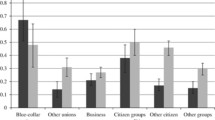Abstract
Political scientists have developed accepted numerical estimates of political ideology for legislators, candidates, parties and even nations, but interest groups lack such scores. This absence puts interest group research at a disadvantage compared to other subfields. I generate ideology scores for 72 groups across 10 years by combining groups’ evaluations of Members of Congress with Poole and Rosenthal’s estimates of Members’ ideologies. Alternative methods are explored, and the validity of the scores is demonstrated. Examinations of the scores focus on the relative distribution of groups and Members of Congress and the link between a group’s ideology and its campaign contributions.
Similar content being viewed by others
References
Ansolabehere, S., Snyder, J. M. Jr., & Tripathi, M. (2002). Are PAC contributions and lobbying linked? New evidence from the 1995 Lobby Disclosure Act. Business and Politics, 4(2), 131–155.
Bailey, M. (2001). Ideal point estimation with a small number of votes: A random-effects approach. Political Analysis, 9(3), 192–210.
Baumgartner, F. R., & Leech, B. L. (1998). Basic interests. Princeton: Princeton University Press.
Carson, R. T., & Oppenheimer, J. A. (1984). A method of estimating the personal ideology of political representatives. American Political Science Review, 78(1), 163–178.
Clinton, J. D., & Meirowitz, A. (2001). Agenda constrained legislator ideal points and the spatial voting model. Political Analysis, 9(3), 242–259.
Downs, A. (1957). An economic theory of democracy. New York: Harper.
Fowler, L. L. (1982). How interest groups select issues for rating voting records of Members of the U.S. Congress. Legislative Studies Quarterly, 7(3), 401–413.
Gopoian, J. D. (1984). What makes PACs tick? An analysis of the allocation patterns of economic interest groups. American Journal of Political Science, 28, 259–281.
Gray, V., & Lowery, D. (1996). The population ecology of interest representation: Lobbying communities in the American states. Ann Arbor: University of Michigan Press.
Gray, V., & Lowery, D. (1997). Reconceptualizing PAC formation: It’s not a collective action problem, and it may be an arms race. American Politics Quarterly, 25(3), 319–346.
Grenzke, J. M. (1989). Candidate attributes and PAC contributions. Western Political Quarterly, 42(2), 245–264.
Grier, K. B., & Munger, M. C. (1993). Comparing interest group PAC contributions to House and Senate incumbents, 1980–1986. Journal of Politics, 55(3), 615–643.
Groseclose, T., & Milyo, J. (2005). A measure of media bias. Quarterly Journal of Economics, 120(4), 1191–1237.
Hall, R. L., & Grofman, B. (1990). The committee assignment process and the conditional nature of committee process. American Political Science Review, 84(4), 1149–1166.
Hall, R. L., & Wayman, F. W. (1990). Buying time: Moneyed interests and the mobilization of bias in congressional committees. American Political Science Review, 84(3), 797–820.
Heaney, M. T. (2004). Outside the issue niche: The multidimensionality of interest group identity. American Politics Research, 32(6), 611–651.
Herndon, J. F. (1982). Access, record, and competition as influences on interest group contributions to congressional campaigns. Journal of Politics, 44(4), 996–1019.
Herron, M. (2001). Interest group ratings and regression inconsistency. Political Analysis, 9(3), 260–274.
Jackman, S. (2000). Estimation and inference are missing data problems: Unifying social science statistics via Bayesian simulation. Political Analysis, 8(4), 307–32.
Jackson, J. E., & Kingdon, J. W. (1992). Ideology, interest group scores, and legislative votes. American Journal of Political Science, 36(3), 805–823.
Krehbiel, K. (1990). Are congressional committees composed of preference outliers? American Political Science Review, 84(1), 149–163.
Krehbiel, K. (1994). Deference, extremism, and interest group ratings. Legislative Studies Quarterly, 19(1), 61–77.
Langbein, L. I. (1986). Money and access: Some empirical evidence. Journal of Politics, 48(4), 1052–1062.
Lewis, J. B., & Poole, K. T. (2004). Measuring bias and uncertainty in ideal point estimates via the parametric bootstrap. Political Analysis, 12(2), 105–127.
Martin, D., & Quinn, K. (2002). Dynamic ideal point estimation via Markov chain Monte Carlo for the U.S. Supreme Court, 1953–1999. Political Analysis, 10(2), 134–153.
Middendorp, C. P. (1989). Models for predicting the Dutch vote along the left-right and the libertarianism-authoritarianism dimensions. International Political Science Review, 10(4), 279–306.
Poole, K. T., & Rosenthal, H. (1991). Patterns of congressional voting. American Journal of Political Science, 35(1), 228–278.
Poole, K. T., & Rosenthal, H. (1997). Congress: A political-economic history of roll call voting. New York: Oxford University Press.
Poole, K. T., & Rosenthal, H. (2007). Ideology & Congress (2nd edn.). New Brunswick: Transaction Publishers.
Poole, K. T., Romer, T., & Rosenthal, H. (1987). The revealed preferences of political action committees. AEA Papers and Proceedings, 77(2), 298–302.
Reinhardt, G., & Victor, J. N. (2007). Stealing the platform: How interest groups affect party campaign platforms. Paper presented at the annual meeting of the Midwest Political Science Association, Chicago.
Segal, J. A., & Cover, A. D. (1989). Ideological values and the votes of U.S. Supreme Court Justices. American Political Science Review, 57(3), 557–565.
Snyder, J. M. (1992). Artificial extremism in interest group ratings. Legislative Studies Quarterly, 17(3), 319–345.
Stimson, J. A. (1991). Public opinion in America: Moods, cycles, and swings. Boulder: Westview.
Todosijevic, B. (2004). The Hungarian voter: Left-right dimension as a clue to policy preferences. International Political Science Review, 25(4), 411–433.
Voeten, E. (2000). Clashes in the assembly. International Organization, 54(2), 185–215.
Voter Information Services. (2003, 2007). Congressional report cards. Retrieved repeatedly from http://www.vis.org.
Weisberg, H. F. (1972). Scaling methods for legislative roll-call analysis. American Political Science Review, 66(4), 1306–1315.
Wilcox, C. (1989). Organizational variables and contribution behavior of large PACs: A longitudinal analysis. Political Behavior, 11(2), 157–173.
Wright, J. R. (1989). PAC contributions, lobbying, and representation. Journal of Politics, 51(3), 713–729.
Author information
Authors and Affiliations
Corresponding author
Additional information
This research would not have been possible without the innovations and contributions of Keith Poole, both to the field generally and to this paper in particular. The author thanks Michael Munger, Jason Reifler, Jay Hamilton, Tom Rice, Keith Poole, Scott de Marchi, John Aldrich, Michael Tofias, Frederick Boehmke, anonymous reviewers, and others along the way for their very helpful ideas and comments.
Rights and permissions
About this article
Cite this article
McKay, A. A simple way of estimating interest group ideology. Public Choice 136, 69–86 (2008). https://doi.org/10.1007/s11127-008-9281-2
Received:
Accepted:
Published:
Issue Date:
DOI: https://doi.org/10.1007/s11127-008-9281-2



